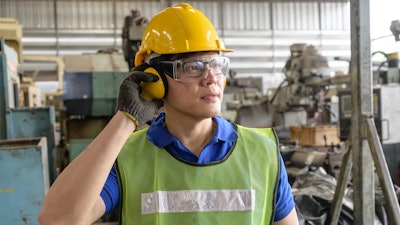
Prolonged noise exposure isn’t just unpleasant and disruptive, but it may also have serious adverse effects on physical and mental health. When workers spend days listening to loud machines, shouts, and other noise, they may develop permanent tinnitus, other issues with hearing, and even hearing loss. Psychological stress is also a common symptom, often leading to decreased productivity and troubles with focus.
According to Occupational Safety and Health Administration (OSHA), anything above 85 decibels over eight working hours is an unacceptable level of noise exposure. In other words, if employees need to raise their voices to speak to each other when standing three feet apart, it’s considered too noisy. To protect their ears, employers need to implement hearing conservation programs.
But hearing conservation methods need to be designed so that they don’t disrupt productivity and safety. While that can be a challenging task for employers, it’s certainly not impossible. In fact, let’s take a look at a few methods you can implement in your own workplace.
Substitute the Noise Sources
When attempting to reduce noise exposure, the first step you should take is to see whether you can eliminate the source. Considering that heavy machinery is primarily responsible for the noise, it might not be possible to fully get rid of it. After all, no one can expect you to replace your expensive equipment entirely.
However, what you could do is substitute the particularly noisy parts, such as saw blades and exhaust valves. Look into newer technology, and you might find excellent options that produce significantly less noise than your old parts. Nowadays, equipment manufacturers understand that low noise levels are a huge selling point, so you shouldn’t have too much trouble finding what you need.
Buying entirely new machine parts can also leave quite a dent in your budget. If you can’t afford such expenses, there are other, smaller adjustments you can make. While they may appear minor, these changes can significantly contribute to noise reduction when added together. For instance, you could identify vibrating machine parts and “dampen” them with various materials. When vibrations transfer into the air, we hear them as noise, and adding rubber, PVC, and polyurethane can significantly reduce this effect.
Aside from that, you can buy silencers and fit them into blowing nozzles and exhaust pipes. Make sure to check them frequently, though. After a while, they’re sure to need replacing if you want them to stay as effective as when you first got them.
Finally, it’s essential to regularly maintain and lubricate your machinery. That way, it will work more smoothly and be less likely to produce excessive noise that may harm your employees.
Communication Headsets
In noisy environments, high-noise communication headsets are almost a must. They significantly improve workflow and efficiency, allowing employees to talk to each other without straining to hear. High-noise communication headsets also have a built-in noise-canceling feature that protects your employees’ hearing from loud sounds. So even when they’re not using the headsets to communicate, you should still advise your workers to wear them.
When operating heavy machinery, sometimes it’s impossible to minimize the noise. Silencers and vibration-reducing materials have no effect, and even noise-canceling headphones do nothing. In such a case, the only thing you can do is to come up with ways to limit your employees’ exposure to noise.
For instance, instead of asking your employees to use noisy equipment during the entire workday, limit the time to only a couple of hours. When taking breaks, your workers should be allowed to leave the noisy environment and seek out a quiet space. If you can, provide such break rooms nearby, but make sure they are soundproof.
All of these methods should help protect your employees from dangerous noise levels. However, if you’re looking to maximize their effectiveness, providing proper training might be in order. Otherwise, your workers might not fully understand the importance of keeping their distance, which would undermine all your efforts.
Finally, your workplace’s layout can greatly contribute to or reduce noise emissions. So, if you have the means, make sure to pay particular attention to how you design the areas where you’ll place your loudest machinery.
Even if you can’t spend thousands of dollars on a redesign and new equipment, minor rearrangements can go a long way in noise reduction. Consider whether you’re doing everything you can for your employees’ safety and comfort. If the answer is no, think about what you could do to effectively change that. Believe us — your workers are sure to be grateful.





















